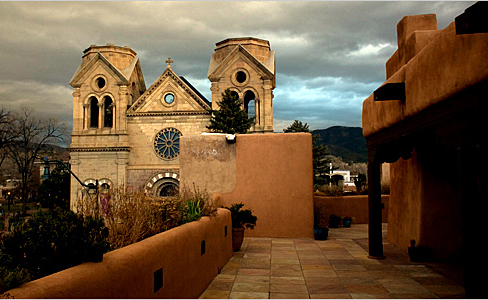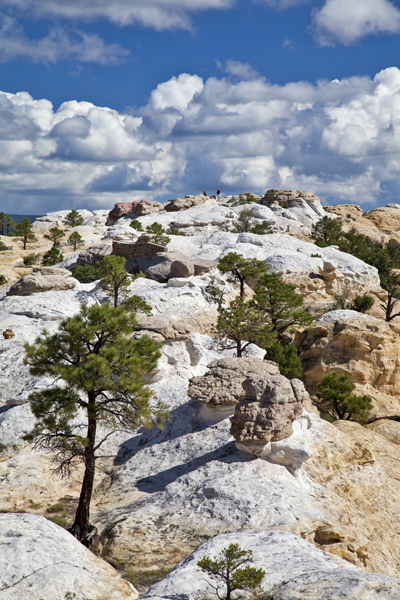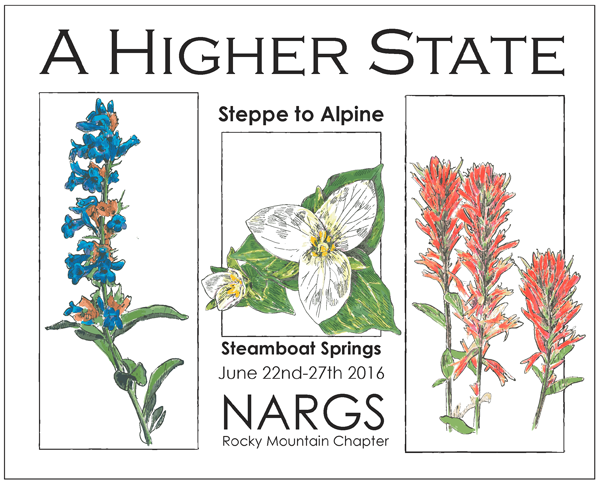
The Cathedral of St. Francis of Assisi
Image by Rick Scibelli Jr. for The New York Times
Annual General Meeting, Santa Fe, New Mexico
August 28-30, 2014 at the Eldorado Hotel & Spa
Santa Fe, the site of the 2014 NARGS Annual General Meeting, is a vibrant multicultural city in a beautiful natural setting. Summer monsoons bring many native plants into bloom during the time that we will be there.
Originally known as La Villa Real de la Santa Fe de San Francisco de Asis, Santa Fe was founded in 1607 by the Spanish on the site of Native American villages and became the capital of the province in 1610. With brief lapses during the Pueblo Revolt and the Mexican-American War, Santa Fe has been the capital of its province, territory, and then finally state since its founding, making the argument that it is the oldest state capital, as well as — at 7000 feet, the highest. In 1846, during the Mexican-American War, General Stephen W. Kearney arrived with his army along the Santa Fe Trail and declared that the New Mexico territory, including Santa Fe, was part of the United States. The Santa Fe Trail, with its Western terminus in Santa Fe, brought many European Americans to Santa Fe, as did the railroads later in the 19th and early 20th Century.
The combination of Native American, Spanish, and European American perspectives permeates Santa Fe, making the art and culture unique and vibrant. The city is a tourist destination and there are excellent museums, world-renowned art galleries, and outstanding restaurants — as well as a variety of shopping opportunities. Much of the city and most of the tourist sites are easily accessible on foot. The Plaza and Canyon Road, home of many art galleries, should not be missed.
To the east of Santa Fe are the Sangre de Cristo Mountains, the southernmost extension of the Rocky Mountains, offering numerous scenic drives and hikes as well as mountain biking and horseback riding. To the south lie the Sandia Crest and the city of Albuquerque. North of Santa Fe are several Native American pueblos and the village of Taos, another tourist destination with restaurants, art galleries, and shopping. To the west are the Rio Grande River and the Jemez Mountains, home of Los Alamos and the Valles Caldera National Preserve. There are many other places well worth visiting in the area, including Bandelier, El Morro, Pecos, El Malpais and Fort Union National Monuments, Chaco Canyon National Historic Park, White Sands National Monument, the Civil War battlefield at Glorieta Pass, and much more.
More information on Santa Fe and the area may be found at these sites:
Top 12 Santa Fe Places to See and Things to Do
Official Travel Site of Santa Fe
The program for the NARGS Annual General Meeting includes a choice of guided hikes in the Sangre de Cristo Mountains, talks from three notable speakers, plant sales from Southwest nurseries, and opportunities to visit local gardens and to explore Santa Fe. No trips are planned before or after the meeting; however there are many activities to do on your own.

El Morro National Monument near Ramah
Image courtesy of Charles Mann Photography
Local wildflower hikes:
Here are some ideas for exploring on your own. More details may be found in the Meeting Program.
There are many diverse ecotypes in the area — from Sonoran desert to alpine environments. The extent of flowering will be dependent on the summer monsoons.
Randall Davey Audubon Center & Sanctuary
Address: 1800 Upper Canyon Road, Santa Fe, NM 87501
This nature preserve contains 135 acres of striking landscapes and wildlife. Bounded by thousands of acres of National Forest and Santa Fe River Watershed land, the Sanctuary provides a peaceful refuge for native plants and animals. Approximately 190 species of birds can be found within the various ecosystems, from riverside riparian areas to piñon-juniper woodlands. Bird, mammal, and plant lists are available for your visit.
Sangre de Cristo Mountains
Ski Santa Fe is scheduled to begin operating a chair lift on August 31 - September 2 that will take you to 12,000 ft. Other than the Taos Ski Basin, this will provide the easiest access in the area to alpine flora and scenic mountain vistas — and possibly some early fall color from the aspens.
Resources:
Visitors will be interested in The Southwest Environmental Information Network. This is a great way to identify plants in the area. One of the nice tools is the ability to build a provisional checklist or a key (limited by the availability of herbarium specimens collected in the area) for any geographic area.
Patrick Alexander's New Mexico Flora has excellent pictures of close to 2,000 taxa.
"Flowering Plants of New Mexico" by Robert DeWitt Ivey, now in its Fifth Edition, is an expensive spiral bound volume.

